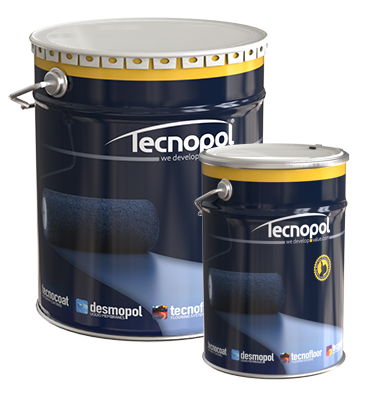GENERAL SPECIFICATIONS
- Two component epoxy water-based resin, solvent-free, odorless, which once dry forms a continuous film in mortar, concrete, bitumen felts, ceramic tiles, and steel increasing adherence for liquid waterproofing and flooring systems
- It holds a CE marking on the basis of a statement made DoP Declaration of Performance (DoP) under the EN-1504-2:2004 table 5
- It must be applied in sound and resistant substrates, with no presence of humidity/water on the surface whether at the time of application or subsequently (pressure from phreatic water level, damp-water). It must be valued the humidity existing on the substrates.
- Its consumption depends on the situation of the substrate, irregularities that it presents or level of planimetry.
- It can be diluted in water (max. 20%), to facilitate application. This action may increase drying and curing times.
PACKAGING
Metallic pails in two different formats:
- LARGE KIT:15 kg+5 kg
- SMALL KIT: 3 kg+1 kg
STORAGE AND SHELF LIFE
12-months shelf life is stored in original containers in a dry environment at a temperature between 5-35 ºC (41-95°F). Keep away from direct sunlight, extreme heat, cold or moisture. Once the tin has been opened, the product must be used.
APPLICATION METHOD
Mortar, concrete or ceramic substrate : Concrete should be completely cured (concrete curing takes 28 days) or, in any case, the maximum level of humidity allowed for the substrate should be verified, depending on the primer used. Concrete must be strong, cohesive and dry, having a correct planimetry, high surface resistance, eliminating laitance, graise, oils or release agents, without excessive irregularities. Therefore, the previous action of sanding, polishing, milling or shot-blasting will be assessed by the applicator to achieve a preparation of the substrate according to ICRI Guide 03732, CSP values 3 to 5. Existing holes or areas with a lack of material must be repaired using some of our epoxy resins: Primer EP-1020/Primer EP-1010. Mastic PU must be used on fissures or small cracks on the surface.Joint filling for installation, work and consolidation of surfaces. General cleaning of the substrate, removing existing dust, dirt, grease or efflorescence. The substrates must be resistant and cohesive. Mix the two components using a mechanical shaker for approximately 4-5 minutes (medium speed). Dilute with water (max- 20%), on non-porous substrates for a thin film, or to facilitate the application in the case of rough substrates. Apply the resin in two or more thin crossed coats until the desired planimetry is achieved. (always wait for drying before recoat). Consumption between 150 and 200 g/sqm depending on the roughness of the substrates. Apply as many coats as the substrate needs. Always respect the recoat time between coats or between different materials. In case of rain, apply a thin layer, consumption approx. 100-150g/sqm.
NOTE: For other types of substrates, weather conditions or final use, consult our technical department.
HEALTH AND SAFETY
Respiratory Protection: When handling or spraying use an air-purifying respirator. Skin protection: Use rubber gloves, remove immediately after contamination. Wear clean body-covering. Wash thoroughly with soap and water after work and before eating, drinking, or smoking. Eye / Face: Wear safety goggles to prevent splashing and exposure to particles in the air. Waste: Waste generation should be avoided or minimized. Incinerate under controlled conditions in accordance with local laws and national regulations. Re-occupancy of the work site without respiratory equipment is minimum 24 hours providing the correct ventilation for the area sprayed. Contractors and applicators must comply with all applicable and appropriate guidelines for storage and safety guidelines.These safety recommendations for handling, are necessary for the implementation process as well as in the pre and post, on exposure to the loading machinery. Dispose waste in accordance with star or/and local regulations.
TECHNICAL AND CHEMICAL PROPERTIES
|
PROPERTIES
|
VALUE
|
|
Density ISO 1675
|
1.00 ±0.1 g/cm³
|
| Viscosity ISO 2555 |
5,000±1,000 cps (non diluted) |
| Density compounds A/B ISO 1675 |
1.15 ±0.05 g/cm³ / 1.12 ±0.08 g/cm³ |
|
Viscosity compounds A/B ISO 2555
|
8,000~15,000 cps / 1,100~800 cps
|
| Mixing ratio (in weight) |
3:1 |
| VOC content |
0 g/l |
| Water content (in weight) |
±45% |
| Determination of adhesion by direct pull-off UNE-EN 1542 (yield 300 g/sqm) |
3.4 MPa |
| Vapor water permeability UNE-EN ISO 7783 (yield 300 g/sqm) |
Sd=15 (Class II) / 1.4 g/sqm/day / µ=128,219 |
| Liquid water permeability UNE-EN 1062-3 (yield 300 g/sqm) |
W=0.0001 kg/(sqm * h0,5 ) (PASS, <0,1) |
| Reaction to fire EN-13501-1:2007+A1:2010 |
Efl |
|
Times: pot-life / dry / recoat
|
60~90 minutes / 5~6 hours / 6~48 hours
|
|
Application temperature range (substrate and environment)
|
3~35ºC / 5~30ºC (37~95ºF / 41~86ºF)
|
| Maximum moisture (substrate/ environmental) |
±15% / ±80% |
|
Dilution (on water)
|
max. 20%
|
Results performed in the laboratory at 23ºC (73ºF) and 50% RH, under controllable conditions. These values may vary depending on the application, climatology, or substrate conditions








